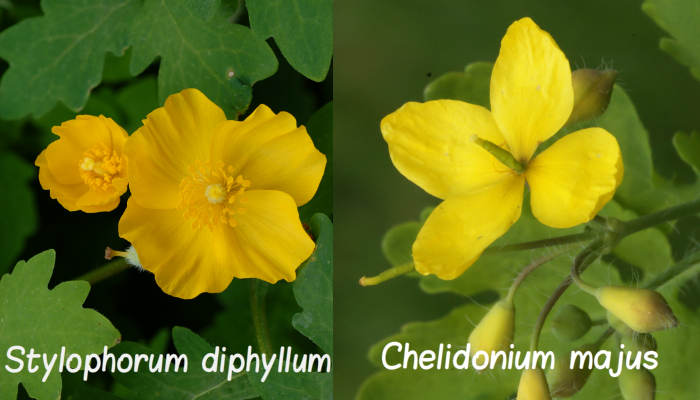Searching for the Native Celandine Poppy

Celandine poppy, aka wood poppy (Stylophorum diphyllum), is native to the forests of the eastern half of the US. Its range extends westward into Wisconsin, Illinois, and Missouri, but so far I have not found it, or found out about it, in Iowa. I did have some expectations to the contrary because most of our spring ephemerals continue westward – many into Nebraska and some into the Black Hills – wherever there are patches of forest. Even with most of the Iowa landscape plowed under or severely overgrazed, I figured there might still be a few somewhere in the state.
But there is another celandine poppy, also sometimes labeled wood poppy (Chelidonium majus), which hails from European woodlands. It was brought to the Colonies and transported westward, because it was deemed to have medicinal value. Its growth form and leaves look rather like the American species, only the flowers are distinctly different in shape, though not in color. And today it is scattered thinly through Iowa’s woodlands.
Also, two other native species are occasionally called celandine. Both are species of jewelweed, the orange-flowered Impatiens biflora and the yellow-flowered Impatiens pallida. These were perhaps labeled celandine because their flower colors are similar to the two poppies. But jewelweed blooms in August-September and look nothing like poppy plants, so no one today should go too far astray, in spite of the same common name.
A few years ago, Dick Baker did a herbarium search for me to learn whether someone a century ago might have collected a rare native Iowa specimen. He came up empty-handed. The trail grows cold.
If the native wood poppy survives anywhere in Iowa today, it is likely to be in the southeastern-most corner. Lee County is home to several other rarest of the rare Iowa natives. They turn up especially in patches of the Shimek Forests located in western Lee and spilling over into eastern Van Buren counties. This is undoubtedly due to the slightly more southern climate plus closer proximity to natural seed sources. And large portions of the Shimek Forests have never been plowed, so rare plant species that colonized that area in prehistoric times still may linger.
So if you are headed that way for spring wildflowers or migrating warblers, check a field guide for details about the American celandine poppy. It is not in Runkel and Bull’s Wildflowers of Iowa Woodlands. Perhaps they never found it, or perhaps they didn’t want undisciplined gardeners digging it up.
Stylophorum diphyllum photo by Nicholas Turland
Chelidonium majus photo by AnneTanne


